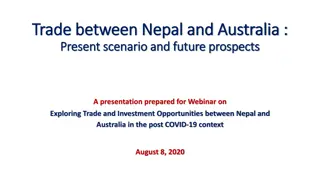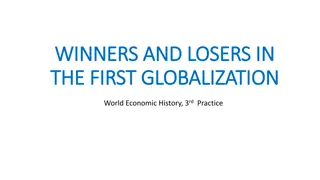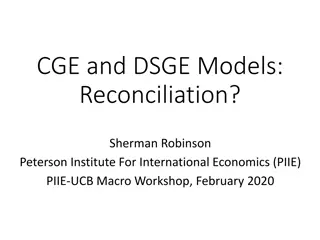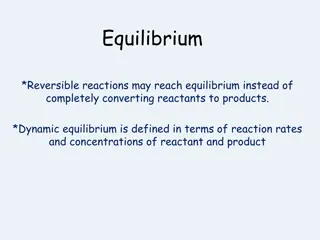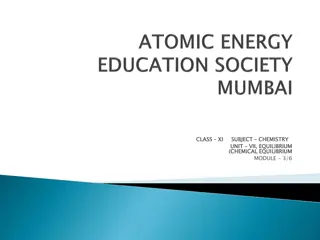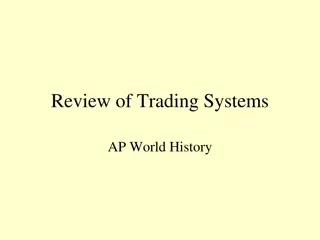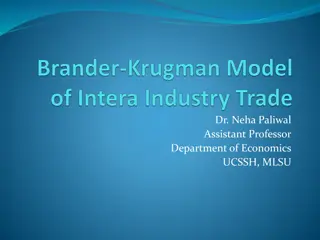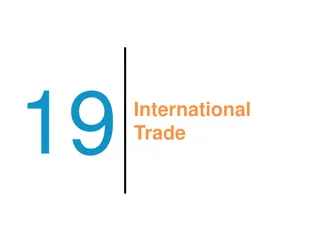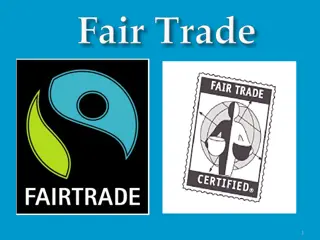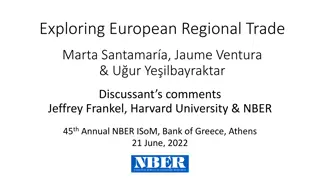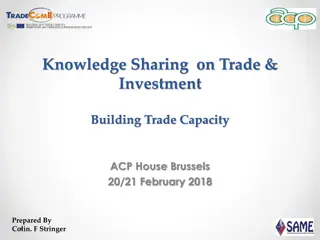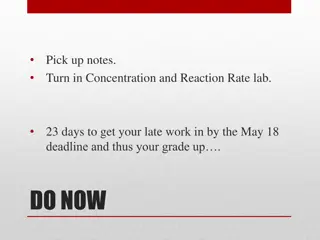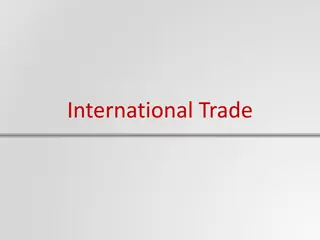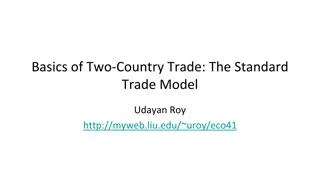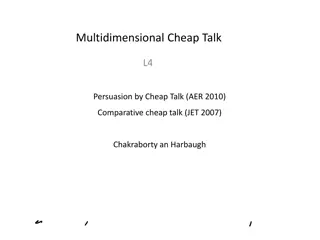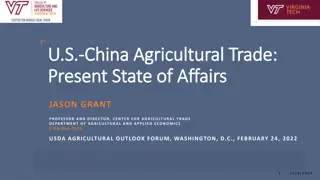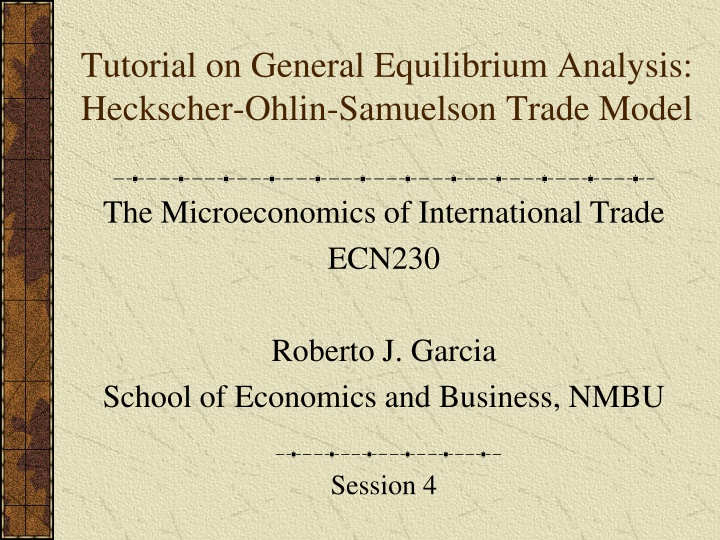
General Equilibrium Analysis: Heckscher-Ohlin-Samuelson Trade Model
Delve into the fundamentals of the Heckscher-Ohlin-Samuelson trade model for analyzing general equilibrium in international trade. Explore the model's specifications, assumptions, and key concepts such as factor endowments, production functions, and market dynamics. Follow a step-by-step walkthrough of a base scenario example to understand how trade impacts production possibilities and factor prices.
Download Presentation

Please find below an Image/Link to download the presentation.
The content on the website is provided AS IS for your information and personal use only. It may not be sold, licensed, or shared on other websites without obtaining consent from the author. If you encounter any issues during the download, it is possible that the publisher has removed the file from their server.
You are allowed to download the files provided on this website for personal or commercial use, subject to the condition that they are used lawfully. All files are the property of their respective owners.
The content on the website is provided AS IS for your information and personal use only. It may not be sold, licensed, or shared on other websites without obtaining consent from the author.
E N D
Presentation Transcript
Tutorial on General Equilibrium Analysis: Heckscher-Ohlin-Samuelson Trade Model The Microeconomics of International Trade ECN230 Roberto J. Garcia School of Economics and Business, NMBU Session 4
General equilibrium trade analysis II Heckscher-Ohlin-Samuelson (H-O-S) model Model specification and assumptions Specification Two countries: North and South Two goods: agricultural (A) and manufactured (M) Two factors: labor (L) and capital (K) Assumptions Identical goods and factors Factor mobility across sectors not across borders Production functions are identical Factor endowments differ Factor intensity in production Competitive markets Resources fully employed; world production = consumption Preferences can be same or different 1
General equilibrium trade analysis II Base situation example 1 Countries are initially closed to trade (autarky) Factor endowment differences Supply of labor: LN< LS Stock of capital: KN> KS Factor intensity in production Production of A (QA) is intensive in the use of L Production of M (QM) is intensive in the use of K Same technology implies identical production functions QA= f(LA, KA) where QA/ LA > 0 but QA2/ LA2< 0 QM= g(LM, KM) where QM/ LM > 0 but QM2/ LM2< 0 Given market info Production Possibilities North Agriculture (A) [Qmax]A Manufacture (M) [Qmax]M Sectors South [Qmax]A [Qmax]M < > 2
General equilibrium trade analysis II Representation of the economies Step 1. Production possibilities curves (PPC) North has an absolute advantage in production of M South has an absolute advantage in production of A M North [Qmax]M PPCN South M [Qmax]M 3 PPCS A A [Qmax]A [Qmax]A
General equilibrium trade analysis II Step 2. Pre-trade production Factor prices LN< LSimplies [PL]N> [PL]S KN> KSimplies [PK]N< [PK]S Relative factor prices: [PL//PK]N> [PL//PK]S Production costs given factor intensity LN< LSimplies [PA]N> [PA]S KN> KSimplies [PM]N< [PM]S Relative goods prices: [PA//PM]N> [PA//PM]S South M North M PN [Qmax]M PPCN [Q0]M [Q0]N [Qmax]M [Q0]M [Q0]S PS PPCS 4 A A [Q0]A [Qmax]A [Qmax]A [Q0]A
General equilibrium trade analysis II Step 3. Pre-trade consumption Budget line is the consumption possibilities curve Suppose preferences for the goods is given as shown below Utility maximization at tangency of SW and budget line Optimal combination of A,M in consumption is at [Co], which includes [Co]Aand [Co]Mgiven prices and income North M PN SWN SWN South M [C0]N [C0]M [C0]S [C0]M [SW0]S PS 5 A A [C0]A [C0]A
General equilibrium trade analysis II General equilibrium, pre-trade situation in North Closed economy: production equals consumption [Qo] = [Co] implies [Qo]A= [Co]Aand [Qo]M= [Co]M [PA / PM]N= M/ A = slope of PPC = slope of SW = slope of budget line Price North M [PA]* Agricultural sector PN [Qmax]M PPCN SWN S D [QD = QS]A [C0]A = [Q0]A QA [C0]N [C0]M [Q0]M Price [Q0]N D S Manufacturing sector [PM]* QM 6 [C0]A A [QD = QS]M [C0]M = [Q0]AM [Qmax]A [Q0]A
General equilibrium trade analysis II General equilibrium, pre-trade in South Closed economy: production equals consumption [Qo] = [Co] implies [Qo]A= [Co]Aand [Qo]M= [Co]Min S [PA / PM]S = M/ A = slope of PPC = slope of SW = slope of budget line Price S D Agricultural sector [PA]* South M QA [QD = QS]A [C0]A = [Q0]A Manufacturing sector Price [Qmax]M [C0]S [PM]* [Q0]M [C0]M [Q0]S [SW0]S PS D S PPCS QM 7 [C0]A [QD = QS]M [C0]M = [Q0]AM A [Q0]A [Qmax]A
General equilibrium trade analysis II Partial equilibrium, pre-trade North South Price S D [PA]* Agricultural sector [PA]N> [PA]S [PA]* S D Q Q [QD = QS]A [C0]A = [Q0]A [QD = QS]A [C0]A = [Q0]A Price Price D S Manufacturing sector [PM]* [PM]N< [PM]S [PM]* D S Q Q 8 [QD = QS]M [C0]M = [Q0]AM [QD = QS]M [C0]M = [Q0]AM [PA/PM]N> [PA/PM]S
General equilibrium trade analysis II Partial equilibrium, pre-trade North South Price S D [PA]* Agricultural sector [PA]N> [PA]S [PA]* S D Q Q [QD = QS]A [C0]A = [Q0]A [QD = QS]A [C0]A = [Q0]A Price Price D S Manufacturing sector [PM]* [PM]N< [PM]S [PM]* D S Q Q 9 [QD = QS]M [C0]M = [Q0]AM [QD = QS]M [C0]M = [Q0]AM [PA/PM]N> [PA/PM]S
General equilibrium trade analysis II Step 4. Prices, pre-trade Budget line: Y = PACA+ PMCM Slope of budget line At [Cmax]M, Y = 0 CA + PM[Cmax]M At [Cmax]A, Y = PA[Cmax]A+ 0 CM Y = Y implies: PM[Cmax]M= PA[Cmax]A [PA/ PM] = [Cmax]M/ [Cmax]A= M / A Differential in the ratio of prices, [PA/ PM] The steeper the price ratio, the higher is PA relative to PM PN= [PA/ PM]Nand PS= [PA/ PM]S PN> PS: [PA ]N > [PA ]Sand [PM]S> [PM]N TOT will be between the existing pre-trade prices PN TOT PS 10
General equilibrium trade analysis II Step 5.World prices, TOT and the price changes Prices in the agricultural sector Price PW Price S D ESA [PA]N* [PA]W* [PA]S* EDA S D QA [QA]T [QD = QS]A [C0]A = [Q0]A [QD = QS]A [C0]A = [Q0]A [PA]T* QA Prices in the manufacturing sector PW Price Price D ESM S [PM]S* [PM]W* [PM]N* EDM D S QM [QM]T [QD = QS]M [C0]M = [Q0]AM QM 11 [QD = QS]M [C0]M = [Q0]AM [PM]T*
General equilibrium trade analysis II TOT is the ratio of world prices: [PA/PM]W Price changes in North: [PA/PM]N> [PA/PM]W PAfrom [PA]Nto [PA]W PMfrom [PM]Nto [PM]W M TOT PN [Qmax]M North SWN' PPCN [Q1]M [Q1]N SWN [C1]N [C1]M [C0]N [C0]M [Q0]M [Q0]N [C1]A [C0]A A 12 [Qmax]A [Q0]A [Q1]A
General equilibrium trade analysis II Price changes in South: [PA/PM]S< [PA/PM]W PAfrom [PA]Sto [PA]W PMfrom [PM]Sto [PM]W South TOT M [C1]S [C1]M [Qmax]M [SW1]S [C0]S [Q0]M [C0]M [SW0]S PS [Q1]M [Q1]S PPCS [C0]A [Q0]A [C1]A A 13 [Qmax]A [Q1]A
General equilibrium trade analysis II Trade triangles TOT: [PA/PM]W= [QM/QA]T Relative prices of A for M on the world market The quantity of A that must be traded to get a unit of M North [Q1]M Export of M [C1]A [C1]M South Import of A [Q1]A [C1]M Import of M [Q1]A [Q1]M Export of A [C1]A TOT 14
General equilibrium trade analysis II Step 6. Welfare implications The change in prices from pre-trade to the terms of trade increases purchasing power in both countries (outward shift in CPC or budget line) and raises utility (SW) The gains from trade results from the process of specialization and trade that improves efficiency and welfare Efficiency in resource allocation Efficiency in production Efficiency in consumption Efficiency in exchange 15
General equilibrium trade analysis II Concluding comments General lessons from the results Price differentials create an incentive for trade A cost-competitive country has a comparative advantage and will be a net exporting country in a free trade situation A high-cost country has a comparative disadvantage and will be a net importing country in a free trade situation Specialization and trade result in gains that represent efficiency in resource use, production, consumption and exchange The optimal amount traded is determined by the TOT bringing all markets into equilibrium Limitations and weaknesses of the model Trade based on factor endowment differences shifts focus of comparative advantage toward supply side factors Demand-side matters are important and likely to play more of a role in trade in the future The underlying assumptions are still important for the results 16

